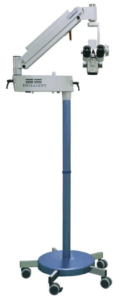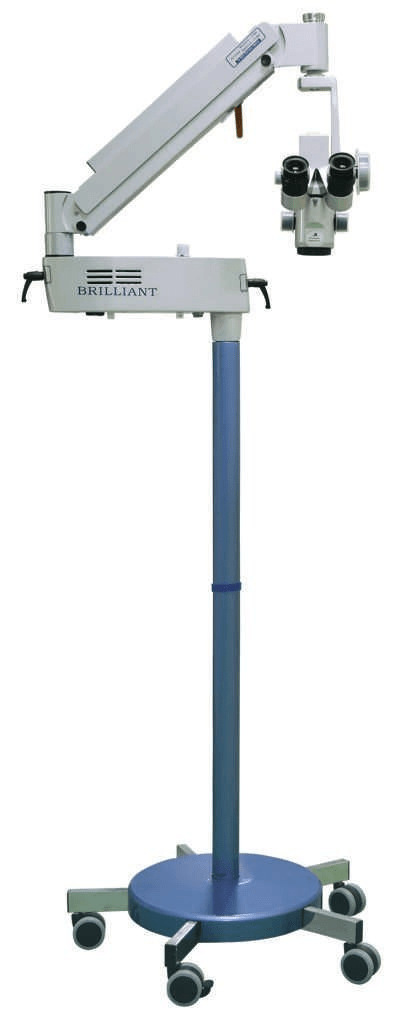Ophthalmic surgical microscope
Surgical Operating Microscope
BRILLIANT
AAOM 230/250 (LED)
FEATURES
-
Counter balanced spring arms for efficient handling
-
Rotatable Filters Including UV Heat-Absorbing Filters
-
Two-Degree Oblique Led Illumination System With Intensity Control
-
Surgical Microscope With Apo-Chromatic Optics

Ophthalmic surgical microscope
Ophthalmic surgical microscope supplier Abu Dhabi
Ophthalmic surgical microscope supplier Dubai
Ophthalmic surgical microscope supplier Sharjah
Ophthalmic surgical microscope supplier Ajman
Ophthalmic surgical microscope supplier Ras Al Khaimah
Ophthalmic surgical microscope supplier Fujairah
Ophthalmic surgical microscope supplier Umm Al Quwain
An ophthalmic surgical microscope is a highly specialized, high-precision optical instrument designed to assist ophthalmic surgeons during delicate eye procedures. These microscopes provide enhanced visualization, magnification, and illumination, allowing surgeons to perform intricate surgeries such as cataract extraction, retinal detachment repair, corneal transplantation, and other microsurgical interventions with extreme accuracy. Equipped with advanced stereoscopic optics, these microscopes offer a three-dimensional view of the surgical field, enabling precise manipulation of micro-instruments and tissues. Most modern ophthalmic microscopes incorporate coaxial illumination systems, ensuring bright, shadow-free lighting that enhances contrast and clarity, essential for distinguishing fine structures within the eye. Additionally, they often feature motorized zoom and focus adjustments, allowing seamless changes in magnification without disrupting the procedure. Many high-end models include integrated digital imaging and video recording capabilities, which assist in documentation, teaching, and real-time collaboration with other medical professionals. Some ophthalmic microscopes are mounted on floor stands with counterbalanced arms for stability and ease of movement, while others are adapted for head-mounted or ceiling-mounted configurations in advanced surgical settings. The incorporation of fluorescence and infrared imaging technologies in some models further enhances the surgeon’s ability to visualize specific ocular structures, such as blood flow in the retina or corneal graft integration. In modern ophthalmic surgery, the evolution of microscopes with computer-assisted robotic control has further improved precision, reducing manual adjustments and allowing for automated positioning based on pre-set preferences. Given their importance in microsurgical procedures, ophthalmic surgical microscopes play a critical role in improving surgical outcomes, minimizing complications, and ensuring better post-operative recovery for patients undergoing delicate eye surgerie
Eye equipment encompasses a wide range of specialized medical instruments used in ophthalmology and optometry for diagnosing, treating, and performing surgery on various eye conditions. These devices are designed with precision to ensure accurate assessment and effective treatment of visual impairments, ocular diseases, and refractive errors. Advanced technologies in eye equipment have revolutionized the field of eye care, allowing professionals to detect early signs of dis
Diagnostic eye equipment plays a fundamental role in assessing eye health and detecting abnormalities. Instruments such as the slit lamp biomicroscope offer a magnified, detailed view of the eye’s front structures, helping in the diagnosis of cataracts, corneal ulcers, and other conditions. The ophthalmoscope enables doctors to examine the retina and optic nerve, which is crucial for identifying diseases like diabetic retinopathy and glaucoma. A tonometer is used to measure intraocular pressure, a key factor in diagnosing glaucoma, while an autorefractor determines refractive errors and assists in prescribing corrective lenses. More advanced imaging technologies, such as optical coherence tomography (OCT), provide high-resolution cross-sectional images of the retina, allowing for early detection of conditions like macular degeneration and diabetic retinopathy
Surgical eye equipment is highly specialized and designed to perform delicate procedures with extreme precision. The ophthalmic surgical microscope is a critical tool in eye surgeries, offering high-magnification visualization with coaxial illumination and motorized focus adjustments. In cataract surgery, a phacoemulsification machine is used to break down and remove the cloudy lens using ultrasonic waves, followed by the implantation of an artificial intraocular lens. Retinal surgeries often require a vitrectomy machine, which removes the vitreous gel to treat conditions like retinal detachment and macular holes. Laser technology has also become an integral part of ophthalmic surgery, with excimer lasers being used in LASIK procedures to reshape the cornea and correct vision. Femtosecond lasers offer superior precision in bladeless cataract and corneal transplant surgeries, leading to faster healing and better outcomes
Apart from diagnostic and surgical equipment, there are numerous therapeutic and visio correction devices designed to improve eyesight and treat eye disorders non-invasively. Intraocular lenses (IOLs) are implanted during cataract surgery to replace the natural lens and restore vision, with advanced options like multifocal and toric lenses providing enhanced focus and astigmatism correction. Contact lenses and spectacles are commonly used to correct refractive errors, with options including soft lenses, rigid gas permeable lenses, and specialized lenses for astigmatism or presbyopia. Orthokeratology (Ortho-K) lenses offer a unique non-surgical approach by reshaping the cornea overnight, temporarily correcting vision during the day. For individuals with severe visual impairment, low vision aids such as magnifiers, electronic reading devices, and telescopic glasses provide essential assistance in daily lif
With rapid advancements in medical technology, modern ophthalmology has embraced artificial intelligence and robotic-assisted systems for improved diagnostics and treatments. AI-powered diagnostic devices are now capable of analyzing retinal images to detect early signs of diseases like diabetic retinopathy and age-related macular degeneration. Fluorescein angiography, a specialized imaging test, helps in visualizing blood flow in the retina to diagnose vascular disorders. Robotic-assisted surgery, such as the PRECEYES system, enhances precision in microsurgical procedures, reducing human error and improving patient outcomes. These technological innovations have made eye care more efficient, accurate, and accessible, ultimately leading to better vision preservation and restoration for patients worldwide
Eye equipment plays an essential role in ophthalmology, enabling early diagnosis, effective treatment, and successful surgical interventions. From routine eye exams to complex laser surgeries, these high-precision tools have transformed the field, ensuring that millions of people receive the best







Reviews
There are no reviews yet.